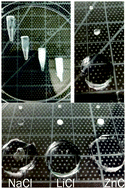Enhanced elasticity in poly(acrylic acid) gels via synthesis in the presence of high concentrations of select salts
Abstract
Poly(acrylic acid) (PAA) gels synthesized via free-radical polymerization of acrylic acid, N,N′-methylenebisacrylamide and high molarities of salts in water exhibit properties markedly different from PAA gels synthesized without salt, even when the latter are incubated in high-molarity salt solutions after gelation. Particularly noteworthy is unusual mechanical behaviour that includes substantially increased elongation, increased modulus, and rapid recovery after strain. The greatest enhancement in viscoelastic behaviour is evident in 2 M LiCl and ZnCl2 samples, with LiCl samples having a modulus of 39 kPa and reaching an extension ratio of 10 and a fracture stress of 135 kPa, and ZnCl2 samples having a modulus of 43 kPa and reaching an extension ratio of 8.5 and a fracture stress of 175 kPa. This enhanced elasticity is thought to be brought about by a combination of coiled but only weakly-entangled PAA chains with phase-separated regions of salt acting as a plasticizer and modulating intermolecular interactions among AA units.



 Please wait while we load your content...
Please wait while we load your content...